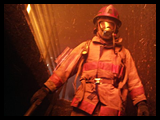
Dr. Barry Spiering a research physiologist with the U.S. Army Research Institute of Environmental Medicine takes part in a controlled burn exercise at the Massachusetts Firefighting Academy in Stowe, Mass., while conducting a study to prevent injury in recruits, Sept 5, 2012. Researchers at Natick's U. S. Army Research Institute of Environmental Medicine have teamed up with the Massachusetts Firefighting Academy in an effort to reduce injuries in recruits.
Photo Credit: Courtesy photo
|
NATICK, Mass. (Sept. 24, 2012) -- Researchers at Natick's U. S. Army Research Institute of Environmental Medicine have teamed up with the Massachusetts Firefighting Academy in Stow, Mass., in an effort to reduce injuries in recruits.
The Massachusetts Firefighting Academy, or MFA, contacted USARIEM's Military Performance Division and asked researchers to evaluate their physical training program for recruits after seeing a spike in training-related injuries.
Instructors for the 12-week program noticed that recruits were showing up not fully ready to handle the physical stress that comes with the academy. As a result, recruits were frequently lost to injury.
"We noticed a recurring pattern of injury with firefighting recruits and reached out to Natick Labs for their specialized expertise on Soldier performance," said Edmund Walker, Mass. Firefighting Academy director. "Our hope was that they could assist us in evaluating the tasks of fighting fires to better prepare our recruits to be successful."
Dr. Barry Spiering, a research physiologist with USARIEM, attended three meetings with the MFA, including an orientation 60 days prior to the recruits reporting to their first day of the academy. He then returned at week 10 of the program to observe and assess recruits during a controlled burn.
Spiering said that injuries, including rhabdomyolysis, frequently occur in highly physically demanding occupations when people exert themselves before they are ready for the stress of that particular job.
Rhabdomyolysis is the breakdown of muscle fibers that leads to the release of muscle fiber contents into the bloodstream. This is harmful to the kidney and can often cause kidney damage.
"We see muscular injuries like rhabdomyolysis often when a person is less fit and not ready for the stress they are about to put on their body," Spiering said. "Rhabdomyolysis is a severe case of injury, but can often happen to people in occupations like firefighting and the military."
Spiering said that with proper knowledge and preparation, however, muscular injuries can be avoided.
"During the orientation, recruits were given educational lectures on health, went through circuit training with weighted gear on their bodies, and were given a workout plan they could perform at home in preparation of their upcoming training," Spiering said. "My goal during this time was to observe and evaluate the effectiveness of the recruit orientation program and send my recommendations to the instructors of the MFA."
The result at week 10 when Spiering returned was that no recruits were lost to injury, which was not often the case in prior classes. Spiering said that the orientation was appropriate and pragmatic for reducing injuries.
"The steps that the MFA have taken to reduce recruits injury are appropriate," Spiering said. "They have done a great job to reduce injury, and this orientation program shows that they are doing the right thing."
Walker said he fully agrees.
"The orientation has helped these young men and women understand their responsibility to themselves if they want to be successful in our firefighter recruit training program," Walker said. "The results have been exactly what we hoped for."
USARIEM provides solutions to optimize war fighter health and performance through medical research
Learn more at Army.mil
|